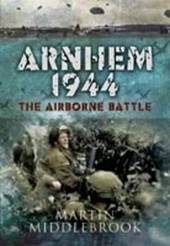
|
Arnhem 1944: The Airborne Battle
Hardback
Main Details
| Title |
Arnhem 1944: The Airborne Battle
|
| Authors and Contributors |
By (author) Martin Middlebrook
|
| Physical Properties |
| Format:Hardback | | Pages:512 | | Dimensions(mm): Height 234,Width 156 |
|
| Category/Genre | Second world war |
|---|
| ISBN/Barcode |
9781848840751
|
| Classifications | Dewey:940.54219218 |
|---|
| Audience | |
|---|
| Illustrations |
24 black & white photos
|
|
Publishing Details |
| Publisher |
Pen & Sword Books Ltd
|
| Imprint |
Pen & Sword Military
|
| Publication Date |
16 July 2009 |
| Publication Country |
United Kingdom
|
Description
Harry Moon and eight fellow members of the Royal Sussex Regiment all volunteered to transfer to B Battalion Machine Gun Corps in January 1917, (later the Tank Corps) to serve in the revolutionary MK IV Tanks. After describing his experiences, training and fighting on the Somme, with the Royal Sussex the book concentrates on service in tanks. The first action was at Messines in the MKIV and Harry's story is embellished with accounts of gallantry by others and anecdotes. After the battle he took part in two tank demonstrations for Royalty. The 3rd Battle of Ypres followed in July 1917 resulting in the death of one of Harry's fellow volunteers. A full and thrilling account of the mass use of armour at Cambrai follows after descriptions of trials of fascines and barbed wire clearing equipment. The Battalion successfully achieved their first, second and third objectives. This was celebrated with a white table cloth lunch on the Hindenburg Support Wire! Disaster was to follow at the attack on Fontaine-Notre-Dame on 23 November where there were 70% casualties. This debacle is analysed in detail. Arnhem was meant to end the war in Europe. The Germans were in retreat from Normandy and seemed to be beaten. Three airborne divisions were to seize the bridges across the great rivers of Holland and unleash the Allied armies into Germany. The Battle of Arnhem was a turning-point in the war, a gamble by Montgomery, using three airborne divisions to capture a series of bridges across the wide rivers that separated a powerful mobile army from the plains of northern Germany. If the bridges had been captured and held, and the ground forces had been able to relieve the airborne forces, then there would have been a good chance of ending the war before Christmas 1944. It all went wrong. The initial operation was successful, the bridges taken by the Americans were relieved by ground troops, but these troops could not reach Arnhem quickly enough. In the meantime, only a small part of the 1st British Airborne Division had reached the Arnhem Bridge. Most of the remainder of the airborne force was held up on the outskirts of the town by German units that turned out to be far stronger than expected a major intelligence failure. After nine days of fighting, the survivors of the division were withdrawn across the Rhine and it was not until many months later that ground forces captured Arnhem. Using the technique he has perfected over twenty-five years of military study, blending meticulous research based on original documents with the personal experiences of more than 500 participants, Martin Middlebrook describes the Battle of Arnhem from start to finish, from one end of that complicated battlefield to the other. On this fiftieth anniversary, he offers a masterly summary of what went wrong in the last major defeat in battle suffered by the British Army. AUTHOR: Martin Middlebrook has written many other books that deal with important turning-points in the two world wars, including The First Day on the Somme, Kaiser's Battle, The Peenemunde Raid, The Somme Battlefields (with Mary Middlebrook) and The Nuremburg Raid 30-31st March 1944 (all republished and in print with Pen and Sword). Martin Middlebrook is a Fellow of the Royal Historical Society and lives near Stroud, Gloucestershire. 24 b/w photographs
Author Biography
Martin Middlebrook has written many other books that deal with important turning-points in the two world wars, including The First Day on the Somme, Kaiser's Battle, The Peenemunde Raid, The Somme Battlefields (with Mary Middlebrook) and The Nuremberg Raid 30-31st March 1944 (all republished and in print with Pen and Sword). Martin Middlebrook is a Fellow of the Royal Historical Society and lives near Boston, Lincolnshire
|